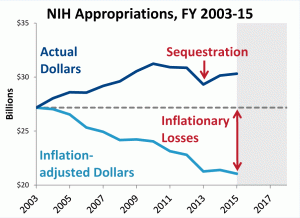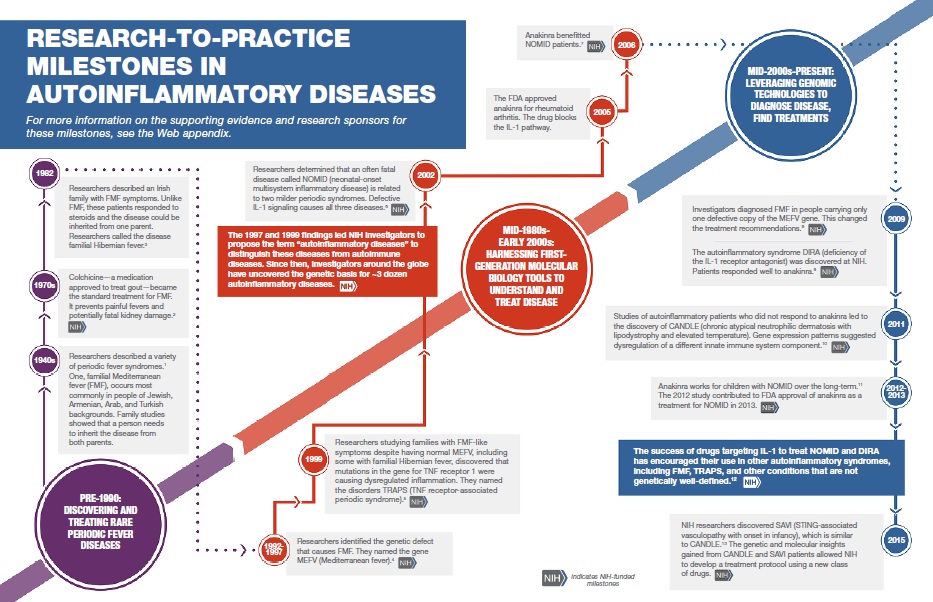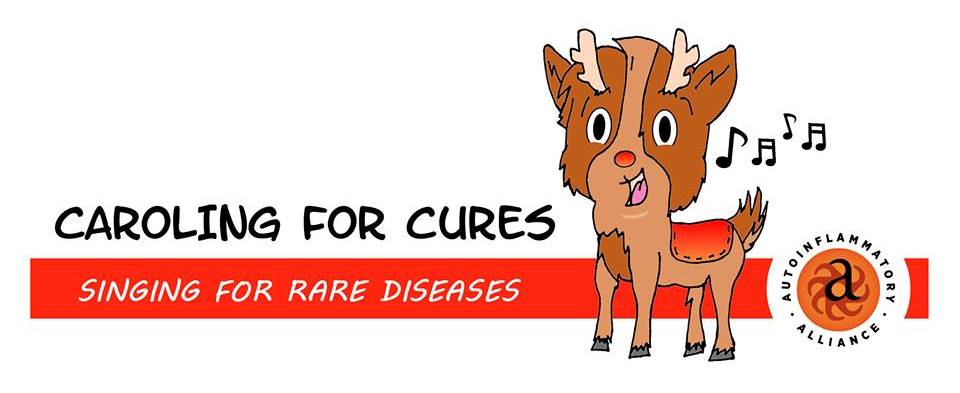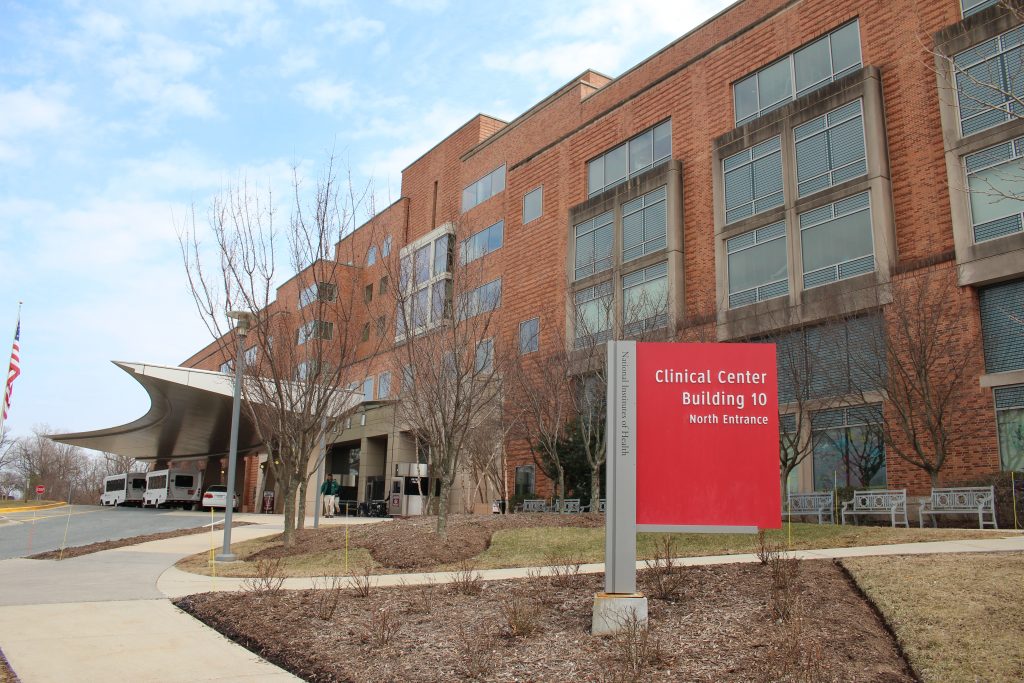
The National Institutes of Health (NIH) is the leading source of research funding for health and biological sciences in the United States. The NIH’s current yearly budget is about $32 billion dollars, which is used to fund research across the country. The total U.S. population in 2016 was about 324,000,000, making a cost of funding NIH research about $100 per person living in the U.S. This money goes to fund grants at research institutions across the U.S. for numerous diseases and health conditions, drug and vaccine development, and much more.
I think that it’s safe to say that the value of NIH research is far more than the actual dollar cost to fund the research. The average family in the U.S. spends more than $100 in a week on food, which is necessary to sustain their life and health. Yet a whole year’s worth of research for all sorts of conditions that could affect a person from birth (or even in the womb) into their old age is being supported by about $100 a year per person in our country. I think that is quite a bargain!

Isaac, who has CANDLE syndrome, celebrated his 10th birthday in style. A birthday that would not have happened without the NIH.
For many the impact of NIH-funded medical and scientific research is felt directly and is priceless, as it has helped to save their life, or that of a loved one. You can read such patient stories here. To learn more about how the NIH helps autoinflammatory diseases, read this post.
NIH research benefits all people, not just those in the U.S. as the advances made to health benefits everyone around the world. This means that over 7.3 billion people benefit from investment in NIH research every year. Research that can help find better prevention, treatments, and understanding of serious common diseases, diseases that could cause a worldwide epidemic, and even very rare diseases which can lead to treatments and discoveries that help more common conditions.
To continue to make great advancements in health care, the NIH needs more funding, not less!
If you agree, scroll to the bottom of this page and follow a few simple steps to encourage your elected officials and others to support more research funding for the NIH!
This short, entertaining video shows how research funding has made a huge impact on treating common and rare diseases.
The majority of NIH funding supports scientific research around the entire country.
Only 15% of the funds are used at the NIH Clinical Center in Bethesda, MD. This funding provides training for the next generation of doctors and researchers in all parts of the country. In addition to benefiting the advancement of medicine in our society, it leads to innovations that create new businesses and inventions that help the local economy.
United for Medical Research (UMR) has a really useful tool here to see how NIH funding in 2016 made an economic impact and the jobs created in each state with their interactive map.
In fact, this statement by United for Medical Research (UMR) President Lizbet Boroughs outlines that a budget of $32 billion for NIH research actually helps to bring in over $60 billion to our economy, which means that for almost every dollar spent on NIH research, two dollars are returned to our economy.
NIH research funding, and with it major health and science advancements are in jeopardy.
To some (including our current President Donald Trump) a $32-35 billion dollar yearly budget to fund the majority of biomedical research in our country is too much. Our president wants to reduce the NIH budget by 18-20%, even though funding for the NIH for the past 15 years has not kept up with inflation, and has been reduced at times, such as with sequestration in 2013. This NIH Research Funding Trends report states that:
From Fiscal Year 2003 to 2015, the National Institutes of Health (NIH) lost 22% of its capacity to fund research due to budget cuts, sequestration, and inflationary losses.
That means our current NIH budget already functions at 20% less than where it should be today; adding a deeper 20% cut would lead to a 40% reduction in NIH research funding compared to 15 years ago.
Imagine if a cut this big happened before the Human Genome Project was launched in 1990!
We may not have ever had the Human Genome Project started, or ever completed if it had not been funded by our Congress. Researchers all around the U.S. and the world worked on the project, and led to the discovery of the genetic cause for over 1,800 diseases. This research also paved the way for autoinflammatory disease research. Note that the Human Genome Project was completed in 2003, two years ahead of schedule and under budget!
Please take a look at these graphs from the Federation of American Societies for Experimental Biology (FAESB) that clearly show how the reduction in NIH funding over the past 15 years has caused great damage to research in the U.S., and how further cuts could cause irreparable damage and impact on the future of health care and scientific innovation in our country. Download their informative one page PDF featuring this information with the download button on their page, and please share it with your elected officials, friends and family.
The loss of research funding over the past 10-15 years has caused a deficit in opportunities and training for the next generation of researchers, which will have a lasting and damaging effect on our society. Further cuts will be difficult to recover from, and the losses will impact our nation, and our world.
NIH-funded research, conducted at academic and medical institutions in communities in every state in the nation, is an engine for medical progress and economic growth. NIH research fuels the pipeline of discovery and innovation necessary to prevent, treat and cure our most vexing diseases and it has a significant economic impact, supporting more than 350,000 jobs across the United States and contributing some $60 billion annually in economic activity. –UMR President Lizbet Boroughs
NIAMS researchers Raphaela T. Goldbach-Mansky, M.D., M.H.S. (left) and Nicole Plass, R.N., M.P.A., U.S. Public Health Service, with a DIRA patient. NIH research has led to the identification and successful treatment of DIRA, a rare autoinflammatory disease.
Credit: National Institute of Arthritis and Musculoskeletal and Skin Diseases (NIAMS), National Institutes of HealthNIH clinical drug trials may be someone’s only hope for a future, or for survival.
Clinical trials for patients that are federally funded mean that any patient that meets the study criteria can be enrolled, regardless of their insurance, financial status, or other barriers. For some patients, an NIH study may be their only option in the world to get help for their rare disease.

My son’s first birthday (flaring with his ever-present rash, fever and pain from his autoinflammatory disease.)
As a parent of a child with a very rare autoinflammatory disease (NOMID) that took the lives of 1:5 children prior to adulthood before the NIH study for a targeted medication for this condition, I can attest that NIH research can save, and greatly improve lives. We nearly lost our son at birth due to his disease, then again when he was 13 months old due to life-threatening inflammation and fibrin clots around his heart (pericardial effusion-near tamponade). In this photo, he was already anemic, weak and flaring with fevers, vomiting and crying from pain and uncontrolled inflammation from his brain to his feet. But he went undiagnosed until he was 3 1/2 years old, and had more complications every year. Thanks to his NIH doctors, he was properly diagnosed, and his medical needs were addressed. He was one of the first patients in the NIH clinical trial with the targeted treatment that has changed his life. Not a day goes by that we are not personally thankful for NIH research that has given our child a future.
The expertise of specialists at the NIH that know such a rare disease, and also collaborate with other experts globally is invaluable. Because of the rarity of his disease, we could not get this level of care locally, even though we live in one of the largest cities in the U.S. and are surrounded by some of the best medical institutions in our state.
Yes, we need to rein in spending and decrease debt, but severely slashing funding that benefits humanity so greatly does not make sense at all.
There is currently debate about how to better rein in costs for research and keep NIH funding more tightly focused, but this is a complex issue. Read more about that here.
I love NASA and all their discoveries, and I was devastated to see the space shuttle program taken out of service a few years ago. I actually had tears as I saw the last space shuttle flown on top of a plane over my city on the way to its final resting place in the California desert. But if I had to choose between funding research for humans on earth, versus the proposed funding a trip to better understand a distant moon or planet, I would prefer more focus on the needs of our people on our own planet.
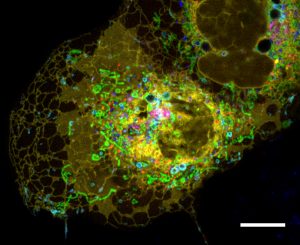
Cell image: Scientists still have not fully discovered everything yet about our cells. Credit: A. Valm, S. Cohen, J. Lippincott-Schwartz, National Institute of Child Health and Human Development, National Institutes of Health
Many experts feel that cutting NIH funding will actually lead to serious health risks to our country, that could undermine our national security and affect everyone in our country.
FASEB President Hudson Freeze, PhD said,
The proposed cut to NIH is, quite simply, a travesty because it threatens the life of every American, harms our economy, and abdicates the United States’ role as a world leader in research. Advances in biomedical and biological research have improved the health of our citizens, generated new treatments for life-threatening diseases, and enhanced our quality of life. Opportunities for additional progress are enormous and at our doorstep, but that promising future success requires sustained and predictable growth in the federal investment in the nation’s research enterprise. The proposed reduction in research funding is unconscionable and endangers the national security of our country.
Read the full FAESB letter here.
Join the Autoinflammatory Alliance, and other organizations in sharing your opinion on the proposed budget cuts today, to help protect research and innovation for the future.
There are a number of ways to let your voice be heard, and it will make a difference:
- Contact your elected officials today on these issues, and tell them how it will impact you and your community. Visit USA.gov and follow the steps to contact your legislators and even the president! Make your case concise, but personal. Calls and letters are noted.
- Rare Disease Legislative Associates (RDLA) has put together a wonderful, concise statement and resources to use here to make it very easy to advocate and let your voice be heard on the current proposed budget cuts.
- Download the FAESB’s informative one-page pdf with all their graphs of the impact of NIH budget cuts over the past 15 years by clicking on the download button on their page, to share with legislators.
- Visit The National Organization for Rare Disorders (NORD) website for helpful tips and ways to take action here.
- Invite your elected official to join the Congressional Rare Disease Caucus. You can even invite them online here (It takes less than 2 minutes!) Make sure to look at the list of members, to see if your legislators are already members.
- Make a donation to support research that you find valuable.
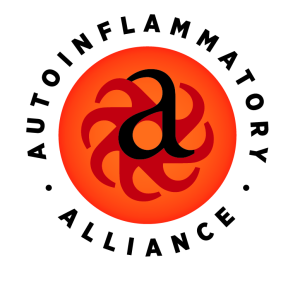
The Autoinflammatory Alliance is a 501 (c)(3) non-profit public charity dedicated to promoting awareness, proper diagnosis and treatment, and improved care for people with autoinflammatory diseases.
The Autoinflammatory Alliance has and will continue to advocate for autoinflammatory patients on this and other issues.
We at the Autoinflammatory Alliance help as an organization by facilitating autoinflammatory disease medical education and outreach, collaborating with researchers on various projects, including the Autoinflammatory Disease Damage Index (ADDI) and funding for autoinflammatory disease research. In the past, we have supported Translational Autoinflammatory Research at the NIH with research funds that we have raised, and have helped with costs for the First Symposium on Autoinflammation and Immune-dysregulation at Walter Reed National Military Medical Center (WRNMMC) that was a joint collaboration between WRNMMC and the NIH.
As budgets get tighter, it is more and more important for organizations to raise funds to help specific research to happen in our country. As an organization, we need to increase our research fundraising to be able to directly fund more autoinflammatory research, but we need your help and support to make this happen.
Donations are welcome anytime! The Autoinflammatory Alliance is a 401c3 non-profit public charity. All donations are tax deductible in the US.
If you are interested in directly supporting NIH research with a donation, that is possible. Contact us here to find out more.
For some other ideas on what to discuss for NIH funding advocacy, please read and share these articles:
FASEB Urges Congress to Reject the Trump Administration Budget Blueprint
New Report on Economic Impact of NIH Research Helps Make the Case for Increased Funding
United for Medical Research Statement on the Administration’s Proposed ‘Skinny’ Budget
Other helpful articles with more in-depth discussions on these issues were used to help us develop this blog post:
New York Times: The Real Threat to National Security: Deadly Disease
Science: Report–The applied value of public investments in biomedical research
Pacific Standard: This Is How Trump’s Budget Cut Would Harm Medical Research
USA Today: Trump’s NASA budget preserves Mars mission, cuts Earth science, asteroid trip, education
The National Institutes of Health: Helping Patients with Recurrent Fever Syndromes for over 20 Years


